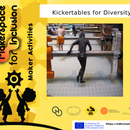Introduction: Microbroadcast /Hyperlocal Radio With Car FM Transmitter
This simple workshop using off the shelf technology can be used to explore radio and to create a very short range local broadcasts. Participants can make their own very local radio transmission. Participants will create recordings on their mobile phone which can then be transmitted to FM radios.
Participants can create one or more collective broadcasts which can be transmitted "very locally" on traditional and newer Dab FM radios. Participants get to explore radio in a playful and physical way. The content for transmission on mobile phone which allows for a type of spontaneus and free use of technology. This activity invites participants to think about transmission, signals and radio whilst co-creating content and encouraging collective listening.
AGES: 8-15
TIME: 2 hours
Maker and learning objectives:
The workshop can be used to transmit and amplify participants voice using radio. Radio has
traditionally been a highly regulated medium which has a rich history to draw on. This workshop can be delivered with very little technical knowledge and with readily available everyday equipment.
This workshop allows experimentation and play with communication technologies, participants
gain an understanding of concepts like transmission, signal and range. This workshop encourages creativity and flexibility, aiming to provide a platform for participants to combine and share material.
Supplies
- We used a Doosl DSER 106 Bluetooth Car Radio Transmitter. This had a great battery life and was simple to use and easy to pair with the bluetooth on a smart phone.
- 1 or more traditional FM Radios capable of tuning to an FM frequency (this can be a traditional radio or a dab version if it is tunable).
- A few smartphones with a bluetooth connection and a voice memo sound recording App.
- Optional : a computer with Bluetooth
- Basic props or everyday objects for making sound effects.
You will use a small consumer FM transmitter as used to transmit mobile phone source via a car radio (there are a range of options and you may be able to get on from a local car accessory shop). A CE marked one means that it is certified not to interfere with other important communication frequencies.
Step 1: Create a Test Transmission
Using a single smartphone and a recording App. make a small easily recognisable test recording together. This can double up as a small warmup for your group i.e Each person says a number in turn (see number stations) or each person makes a sound of an animal or alien. You can use a pre-installed voice recorder or download a voice recording App of your choice.
Step 2: Turn on and Tune In
Turn on your radio or radios, look for an empty frequency with just noise and no radio transmissions*. Make sure they are set to the FM frequency. If possible let participants tune the radio in themselves. Some radios may have a slight offset so take time to get tuned in. We found 99. mhz to be good frequency in our area but the right frequency will depend on your own locality and the frequencies in use there. *(It’s a good idea to test equipment & check good frequencies before the workshop).
Step 3: Turn on the Bluetooth FM Transmitter
Set it to the same frequency as the radio and play your pre-recorded file/files on the radio/radios.
Step 4: Brainstorm
Now divide participants into smaller groups and ask participants to work together on idea for a small radio transmission - This could be: a piece of sound art, a story, a song, a short radio play, a poem or piece of text, an interview. Provide some basic everyday materials props for sound making. Give participants some time to brainstorm together.
Step 5: Record
Once they have decided let them prepare and record their transmission on their phone. This may take one or more takes. Get them to clearly name their finished file.
Step 6: Transmit and Range
Each of the groups can either transmit directly to radio from the groups phone or you can transfer all the files on to one device or if available a computer with bluetooth.
The FM transmitters range to radio is about 4.5 meters. The Bluetooth range from mobile is about 9 meters.
Step 7: Expand
The workshop can be expanded to create a larger more sustained project and participants could create a station/broadcast for a small public venue such as a shop, café, or community centre. Participants can also create a graphic identity and name for their station.
Step 8: Workshop Expansion
These references can be used for workshop expansion:
This article "Five times radio changed the world" discusses different ways that radio instigated social and societal change and mentions one of the most famous radio broadcasts: Martin Luther King's 'I Have a Dream' speech, which described a vision of racial equality in America as well as the https://www.bbc.co.uk/newsround/47199110
Speak Louder: Rediscovering the Power of Voice: https://medium.com/speak-louder/rediscovering-the-...
The workshop can be adapted to explore different thematics based on the participants interests/needs and guided by the workshop facilitators. It is a hands-on and low-stress way of learning and can be applied to a range of settings, starting from a static location such as the workshop venue to a public location such as the street, market or other public space.
Artist Hannah Kemp-Welch's project exploring hyperlocal radio in a community setting: https://www.kettlesyard.co.uk/hyperlocal-radio/
Very Short visual history of radio: https://electronics.howstuffworks.com/history-of-...
How Radio works : https://electronics.howstuffworks.com/history-of-...
Foley was originally used for radio plays & is now used for film, this is a guide to Making Sound Effects aimed at kids & young people: https://electronics.howstuffworks.com/history-of-...
Number Stations About https://electronics.howstuffworks.com/history-of-...
Number Stations Recordings https://electronics.howstuffworks.com/history-of-...
VLF Guide recording guide : https://electronics.howstuffworks.com/history-of-...
VLF sounds https://electronics.howstuffworks.com/history-of-...
Sound clips for remix https://electronics.howstuffworks.com/history-of-...













